We interrupt this series by Charles Herrick (on the SHAEF censorship system and the travails of Robert Capa’s D-Day film therein) for the following public service announcement:
On Tuesday evening, June 18, I will make my first New York City presentation on this five-year research project. “Exploring the Robert Capa D-Day Myth,” a dialogue with Artists Talk on Art (ATOA) Chairman Emeritus and technologist Douglas I. Sheer, will take place at 6:00 p.m. at the venerable National Arts Club, 15 Gramercy Park South, New York, NY 10003 (20th Street, 1/2 block east of Park Ave.) Doors open at 6:00 p.m.; panel starts at 6:30 p.m. — $10 general admission, $7 students and seniors (with ID). Pass-holders & NAC Members free. Payment can be made in advance through PayPal (at atoa.org).
•
Though I hope to have other such opportunities in the future, who knows when that might occur? So, if you’re in the New York area, I recommend taking advantage of this one if you can. Doug Sheer is my oldest friend (we played together in the sandbox as Greenwich Village toddlers), and has followed this investigation from the start, so, after a short synopsis of our efforts to date, I anticipate some informed questions from him before we turn it over to the audience.
Capa D-Day Revisionism Forges Ahead
The 75th anniversary of D-Day came on June 6 of this year, and has now itself passed into history — sufficiently past that it seems likely we will have no new versions of the Capa D-Day story in relation to this year’s marking of that occasion.
So this seems an appropriate moment to review the most recent commentaries on Capa’s D-Day images and the story behind them, to see what effect our investigation, which marked its fifth anniversary on the same day this year, has had on the narrative. It pleases me to announce that, given the skimpy coverage of our work by the press here in the U.S., the impact of our research on this year’s Capa D-Day coverage proved considerable.
•
 Most unexpectedly, we found “The Story Behind D-Day’s Iconic Images,” by Michael Hedges, datelined June 5, 2019 and published at the website of the American Association of Retired Persons (AARP). The D-Day features in the June 2019 AARP Bulletin, written by Capa’s unofficial biographer Alex Kershaw, don’t mention our project; the spread reproduces but doesn’t comment on Capa’s “The Face in the Surf.” But this piece, by the editor of AARP’s print and online publications, foregrounds the results of our inquiry. After the subhead “Robert Capa took the most famous photos, but is the story behind those pictures a myth?” and a summary of the fabulation, Hedges writes,
Most unexpectedly, we found “The Story Behind D-Day’s Iconic Images,” by Michael Hedges, datelined June 5, 2019 and published at the website of the American Association of Retired Persons (AARP). The D-Day features in the June 2019 AARP Bulletin, written by Capa’s unofficial biographer Alex Kershaw, don’t mention our project; the spread reproduces but doesn’t comment on Capa’s “The Face in the Surf.” But this piece, by the editor of AARP’s print and online publications, foregrounds the results of our inquiry. After the subhead “Robert Capa took the most famous photos, but is the story behind those pictures a myth?” and a summary of the fabulation, Hedges writes,
“… It’s a great yarn that Capa and Morris retold all their lives — Morris died in 2017 — and that countless others repeated. But this year the photography website PetaPixel published a detailed examination of Capa’s activities that day that could change the narrative.
“The piece, written by A. D. Coleman, concludes that Capa got to a relatively less dangerous section of the beach than he claimed and stayed about 15 minutes — probably taking only the 11 surviving images — before returning to a landing craft headed back to the invasion fleet. Capa had admitted to a panic attack, but another motive, according to published accounts, was the need to make a tight deadline so his photos could reach the U.S. in time for Life’s next issue.
“And the tragic lab accident? The PetaPixel piece quotes experts saying it couldn’t have happened the way it was described. …”
AARP is one of the biggest organizations in the country, in terms of membership. Its main publication, AARP The Magazine, gets huge distribution (38.3 million), and I assume its website reaches many members, plus others. Though not a long article, this piece by Hedges does direct readers to the full text of my lecture at PetaPixel. And it does basically accept without reservation our research.
This shows that our work has begun to affect not only the discussion of these images within our relatively narrow fields — photo history and photojournalism — but has worked its way into material prepared for a wider, less specialized audience. Heartening, to say the least.
•
At his blog British Photographic History (“Information and discussion on all aspects of British photographic history”), in a short review of the exhibition “Robert Capa: D-Day in 35mm” at the Imperial War Museums in London, Dr. Michael Pritchard wrote,
” … These photographs were published in the 19 June 1944 edition of LIFE Magazine. With a circulation of approximately 3.25 million copies, they helped shape the world’s visual understanding of the landings. Although much of the mythology around the taking of these images and their subsequent integration into the history of photography has been demolished by A D Coleman, the images still powerfully record the D-Day landings. …”
Pritchard is the Director of Education and Public Affairs at The Royal Photographic Society, from which I received the J Dudley Johnston Award in 2010.
•
Leica devotee and historian Erwin Puts folded our investigation into his review of a recent book on Capa’s lover, photographer Gerda Taro, at his blog Rangefinder: Views on the photographic universe. In “The girl with a Leica,” datelined May 8, 2019, he writes,
“Most Leica aficionados are familiar with the (iconic) picture of Rodchenko (Girl with a Leica) from 1934. Recently a book with the same title has been published in 2017, written by Helena Janeczec. It is about Gerda Taro, the friend of Robert Capa. She was a very good photographer herself, better even then Capa. She died in the Civil War in Spain. The story is simple. Capa got a second-hand Leica from a friend, but hardly used it. He gave the camera to Gerda, who used it all the time. Capa himself used the Contax camera and also had a Rolleiflex with him.
“The Leica people stubbornly insist that the Capa pictures (the well-known ‘dying soldier’ is one of them) were made with a Leica, which is not true. It is a fact beyond doubt that the D-day pictures were made with a Contax. The story behind these pictures is rather fascinating and AD Coleman is one of the main investigators to find the truth. It seems that the actual heroism of Capa is less impressive than the myth. And the poor guy in the darkroom did not screw up the rolls of films as is often claimed.
“Even the dying soldier may be a staged scene. No one knows for sure. …” (All spelling in the original.)
•
Like the dog that didn’t bark in the Sherlock Holmes story “Silver Blaze,” several charter members of the Capa Consortium became notable for what they didn’t do on this momentous occasion.
 Magnum Photos, for example, offered a tacit acknowledgment of our work — implicit in their decision not to reiterate either the myth of Capa landing with the first wave or the darkroom-disaster fable. From this we conclude that our research has begun to turn the tide, even among the most resistant.
Magnum Photos, for example, offered a tacit acknowledgment of our work — implicit in their decision not to reiterate either the myth of Capa landing with the first wave or the darkroom-disaster fable. From this we conclude that our research has begun to turn the tide, even among the most resistant.
In the “Conflict” section of this picture agency’s website, in an unsigned piece titled “The 75th Anniversary of D-Day and the Allied Invasion of Normandy,” they wrote this about their founder’s images of the invasion:
“… Early on the morning of the 6th, Capa left Weymouth and landed on Omaha beach alongside the soldiers. After taking photographs in the breaking waves, at times almost submerged, Capa claimed in his book, Slightly Out of Focus, that he was struck by a bout of panic, and fled the beach toward a retreating landing craft. Once in the comparative safety of the craft’s assigned mothership he photographed casualties during the journey back to England. …”
You can’t really describe knee-deep surf as “breaking waves.” And even Capa himself never claimed to have gotten “almost submerged” in such shallows. More egregious fictioneering. Still, we can feel grateful for the absence of the emulsion-melt fable.
At its Twitter feed, Magnum had only this to say:
•
I note also that the International Center of Photography has remained strangely silent on the subject this time, at that institution’s main site and its blog, as well as its FaceBook page. Apparently they decided to muzzle Cynthia Young, Curator of ICP’s Robert Capa and Cornell Capa Archive, to prevent her from doing any more damage.
•
On the other hand, Time, Inc., another charter member of the consortium, maintained its research-challenged commentary from early 2017 on “The Face in the Surf.” Almost everything in this puff piece is wrong, and we have demonstrated that exhaustively. Apparently no one at TIME cares, though I dissected this sometime after it first appeared and notified the editors there of its many failings.
TIME also decided to compound its earlier errors with a nonsensical post to its Twitter feed: “Robert Capa’s ‘D-Day’ photograph is one of TIME’s 100 Most Influential Images of All Time. See how Capa, the only still photographer to wade with the 34,250 troops onto Omaha Beach during the landing 75 years ago, captured this moment.”
Total bullshit. These people have no shame. Other still photographers waded in to Omaha Beach with the troops that morning, including Herman V. Wall of the U.S. Signal Corps, who lost a leg but saw to it that his film got to London, where his images became the first from the beach sent out worldwide. (I’ll have more to say about Wall in a future post.)
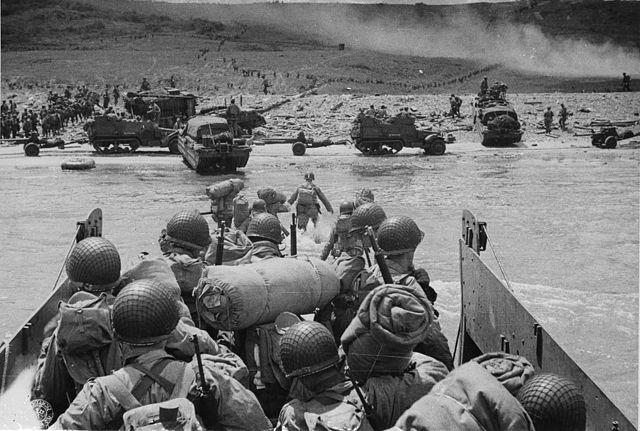
Herman V. Wall, the 165th Signal Corps Photo Company getting ready to land on Omaha Beach on D-Day, June 6, 1944
Signs for Wonders?
Ever hopeful, I find encouraging such manifestations as the June 6 feature in the New York Times, whose “D-Day in Photos: Heroes of a More Certain Time,” by Alan Cowell, reproduces Capa’s “The Face in the Surf” as a two-page spread in the first section of the print edition (and full-screen in the online version here). But the editors captions the image generically — “American troops landing at dawn on Omaha Beach in Normandy, France, on June 6, 1944” and thus avoid any mention of the dubious identification of Huston “Hu” Riley as the subject.
Meanwhile, Cowell does not reiterate any aspect of the Capa D-Day myth in the main body of his article. Indeed, aside from his credit line on this and another of his images (one made aboard the USS Samuel Chase on the night of the crossing) Capa goes unmentioned in the article — evidence, perhaps, of what now gets called “an abundance of caution” on the parts of the writer and editors.
•
In that same vein, I note also the 75th anniversary D-Day interview that NBC’s Tom Brokaw conducted recently with Steven Spielberg and Tom Hanks.
Though not addressing our project directly, Spielberg dropped his previous recitation of the darkroom myth, even while showing two of Capa’s photos (frame 1 of the landing, and “The Face in the Surf”). Brokaw’s narration reduced the Capa mention thusly:
“Spielberg studied the precious few surviving images by famed combat photographer Robert Capa to bring the battle to life.”
Director Spielberg’s original comments about the influence of Capa’s images on Saving Private Ryan simply reiterated the myth uncritically; his status as a Hollywood heavyweight thus both endorsed and perpetuated the legend’s misrepresentations. The new comment credits Capa as a source, without amplifying his fabrications.
Ship of Fools
As the many stories commemorating D-Day accumulated earlier this month, it appeared our research had made an impact, as most of the examples above suggest. At the same time, the durability of the myth also became obvious, in other examples:
• At the Los Angeles Times, Army Lt. Col. M. L. Cavanaugh, “a non-resident fellow with the Modern War Institute at West Point,” worked up a hyperventilated version, “The D-day photos that must be seen,” published on June 2, complete with a link to a 2004 article by John Morris repeating his boilerplate version of the story — blissfully oblivious to the fact that Morris had recanted this shortly before his death.
• At Euronews, in “D-Day 75th anniversary: Eight human stories from the largest seaborne invasion in history,” published on June 6, 2019, Joël Chatreau & Lauren Chadwick wrote,
“War photographer Robert Capa snapped 144 photographs in six hours on D-Day. The Hungarian reporter worked for the American weekly magazine Life and volunteered to be part of the first wave on Omaha Beach.
“He was evacuated unconscious by nurses who thought he was dead, but he was never wounded. [Emphasis added.]
“Most of his photos melted during their development, but the eleven photos that remain are called the ‘Magnificent Eleven.'”
• Erik Lacitis at the Seattle Times, perhaps predictably, repeated the fiction that local hero Huston “Hu” Riley encountered Capa on Easy Red and thus became “The Face in the Surf.” (See “75 years ago, an anxious Seattle turned to radio, newspapers to learn about the D-Day invasion,” June 2, 2019.) Click here for Charles Herrick’s analysis of this misattribution.
• In what appears to constitute another case of “borrowed glamour,” Karin McQuillan in “My Father’s D-Day Memories,” published on June 5th, 2019 at the website AM/American Greatness, offers some highly unlikely recollections of Capa and his brother Cornell by her late father, U.S. Signal Corps photographer Phil Schultz. These included the following:
“Before we went off to the invasion, about month or two before, when I was assigned to London. I spent a lot of time with Robert Capa (the older brother of a best friend from the Bronx). … [Neither Robert nor Cornell had any connection to the Bronx. — A.D.C.]
“The first thing that happened to me when we got on the beach, it was quiet already, I bumped into a United Press correspondent who I knew from London, because of Robert Capa, and the first thing he said was, ‘Capa is missing.’
“I said, ‘Oh, God!’ and the first thing that came to my mind was what am I going to tell Julia, his mother. I was very close to his family, he was like a big brother to me. For three days, I really worried.
“I went into Sainte-Mère-Église, which we just captured earlier that day. It was in the movie ‘The Longest Day,’ where the paratrooper got stuck on the steeple. That was the village. It was right on the waterfront practically, just to the right of us. For three days I worried whether Capa … I didn’t know it, but before I even got to the beach he got his pictures and he was back in London. He wouldn’t trust his pictures to anybody. He got back on the boat and went back on one of the ships and got himself back to London to the labs to print his pictures.
“His darkroom assistant was so excited the negatives were rushed back before the battle was over, that he melted them in his haste, and only a few images survived. …”
•
To round this out, here’s a link to a Twitter thread — “Robert Capa’s D-Day photos show an American soldier’s view of war” — where more people who should know better make fools of themselves:
Brian Klaas, @brianklaas, 6/6/19: “Robert Capa landed on Omaha Beach on June 6, 1944. He was the only civilian photographer who risked his life to document the Allied invasion. Capa took 106 photos that day. All but 11 were destroyed in a processing accident. The surviving ones are called The Magnificent Eleven.”
To his credit, a follow-up tweet adds, “(Also, some recent research suggests there never were missing photos and there were only ever 11 from D-Day).” Ten, actually, but who’s counting?
•
David Friend, @DavidMFriend1 wrote: “A day to re-read Marie Brenner’s @VanityFair story on Robert Capa & his D-Day-landing photographs.”
By all means, re-read the Brenner article — keeping in mind that it functions as hagiography rather than journalism, giving the late John Morris all the space he wanted to repeat his fabulation unchallenged. This puff piece, plus the equally mendacious TIME video from the same period, set us off on this inquiry back in June 2014.
•
So yes, the myth persists, as we can also see from these and other recent reiterations thereof. It will take time to dislodge it, and that may never happen completely; it’s become a meme, viral even before the web. But our efforts have borne fruit, as a result of which those who do repeat it from now on will brand themselves as lazy and irresponsible in the minds of more knowledgeable people..
•
(For an index of links to all posts in this series, click here.)
•
Special offer: If you want me to either continue pursuing a particular subject or give you a break and (for one post) write on a topic — my choice — other than the current main story, make a donation of $50 via the PayPal widget below, indicating your preference in a note accompanying your donation. I’ll credit you as that new post’s sponsor, and link to a website of your choosing.
 Include a note with your snail-mail address (or email it to me separately) and I’ll include three (3!) copies of The Silent Strength of Liu Xia, the catalog of the 2012-13 touring exhibition of photos by the dissident Chinese photographer, artist, and poet, who, after eight years of extralegal house arrest in Beijing, finally got released and expatriated to Germany in 2018. The first-ever publication of her photographic work, it includes all 26 images in the exhibition, plus another 14 from the same series, along with essays by Guy Sorman, Andrew Nathan, and Cui Weiping, professor at the Beijing Film Academy. Keep one for yourself, share the others with friends.
Include a note with your snail-mail address (or email it to me separately) and I’ll include three (3!) copies of The Silent Strength of Liu Xia, the catalog of the 2012-13 touring exhibition of photos by the dissident Chinese photographer, artist, and poet, who, after eight years of extralegal house arrest in Beijing, finally got released and expatriated to Germany in 2018. The first-ever publication of her photographic work, it includes all 26 images in the exhibition, plus another 14 from the same series, along with essays by Guy Sorman, Andrew Nathan, and Cui Weiping, professor at the Beijing Film Academy. Keep one for yourself, share the others with friends.



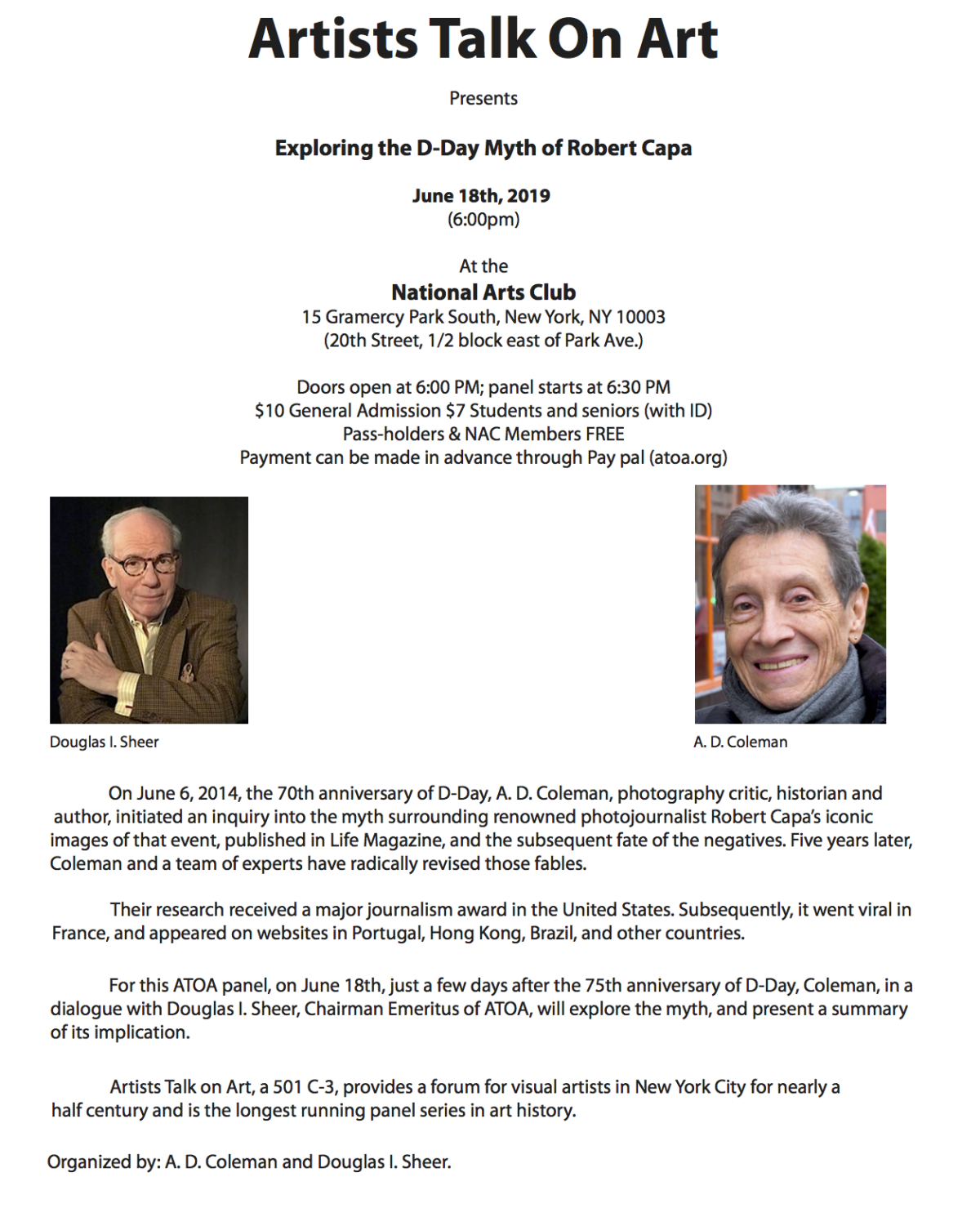
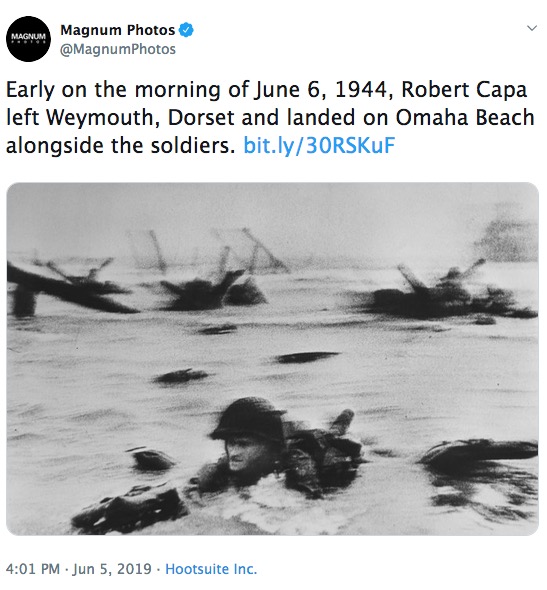
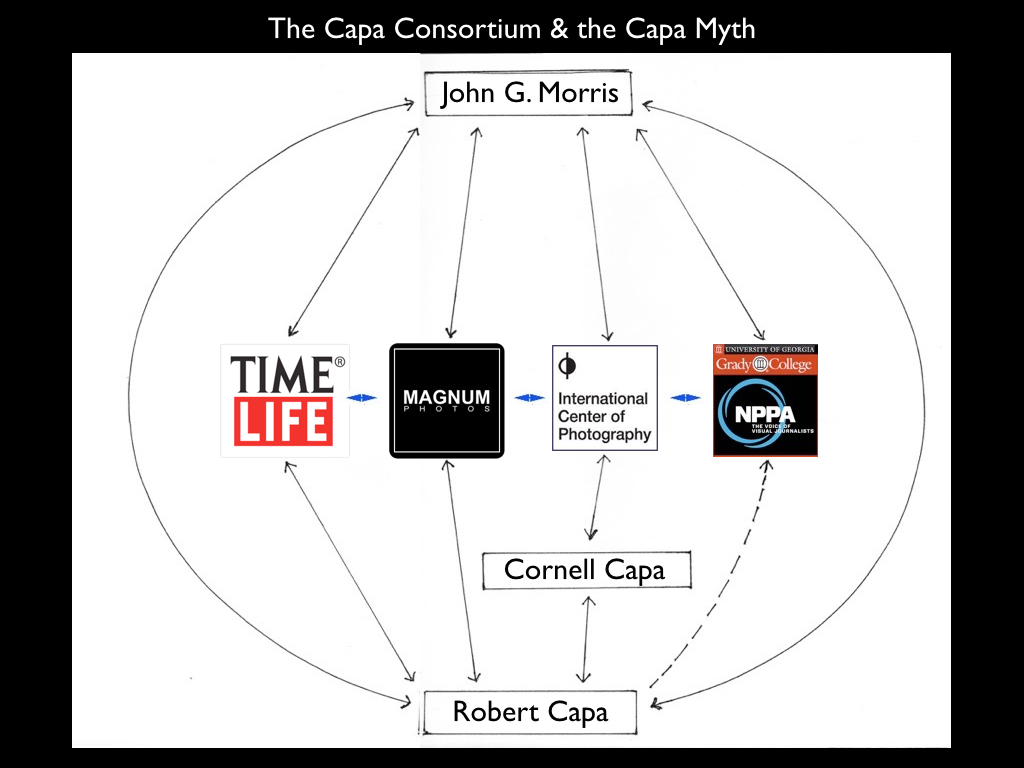
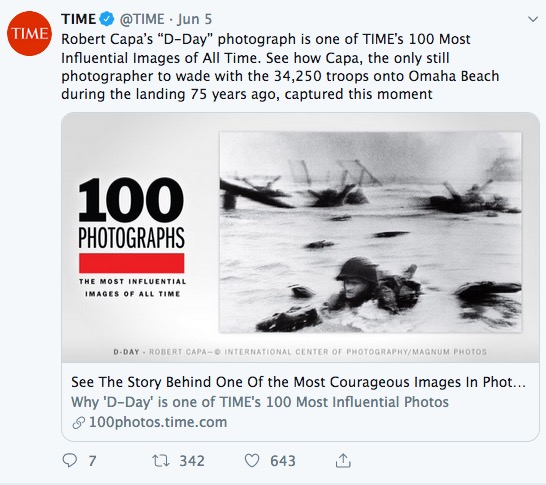
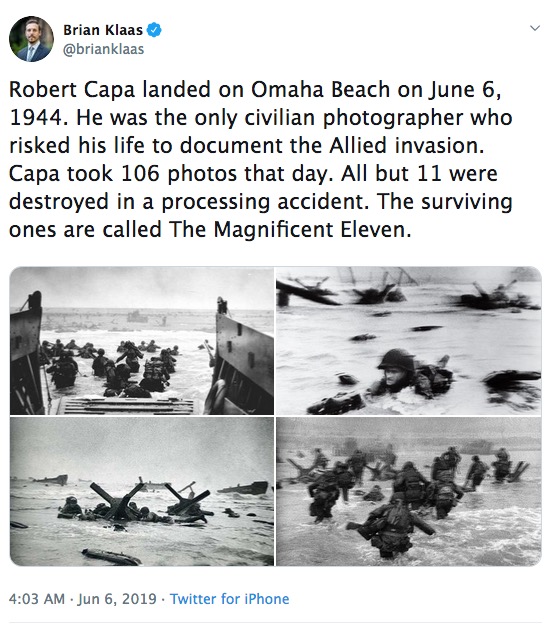
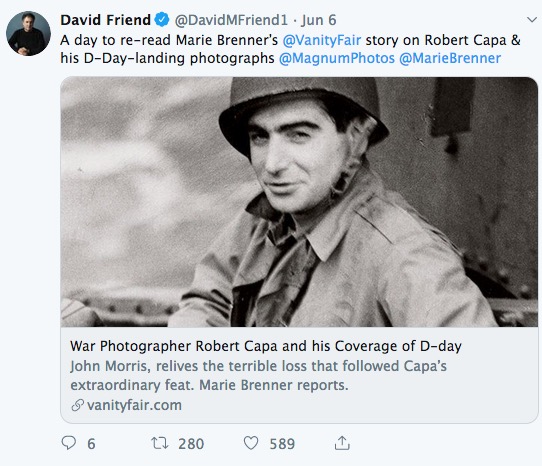
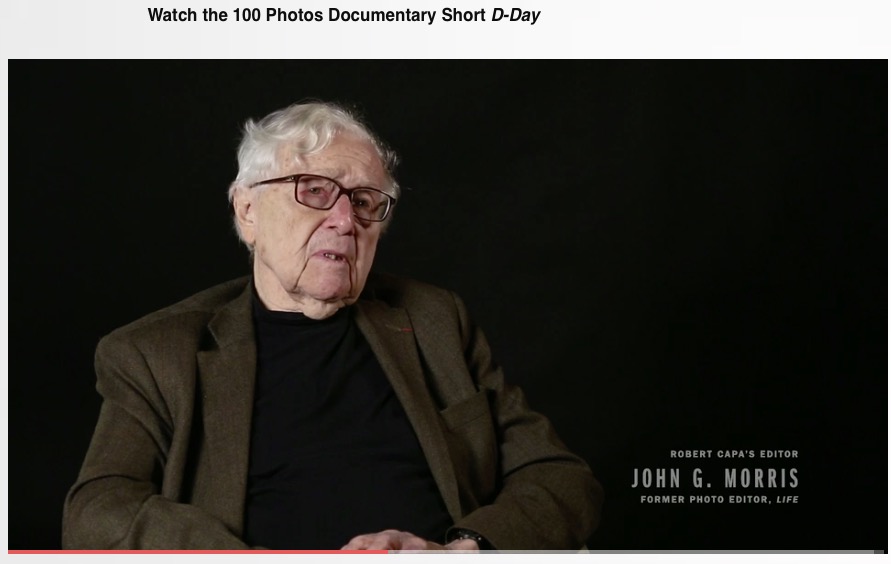




Dear AD,
You won’t remember me, of course, but we met at a garden party in Philadelphia some years back. I’m writing just to say or give kudos for your persistence in debunking myths, esp the Capa D-Day one. I’ve never understood the adulation given the “man in the surf’ when there were/are so many better images from D-Day available.
Anyway, I seem to share some of your inclinations. My books on Ralph Eugene Meatyard (and my forthcoming one on Anne Brigman) really take their genesis from my impatience with people’s foolish mythologizing of some photographers. Just one silly example: people CANNOT get over the fact that REM was born in Normal, Illinois because he made such un-normal photographs. They’ve never heard of Normal Schools, it appears.
And poor Anne Brigman … but that’s another story.
Yes, people always want to “print the legend” but the problem with that is that it almost always obscures the more interesting and richer truth.
Of course I remember you. And I know and respect your work on Meatyard.
Looking forward to your book on Anne Brigman.
Thanks for your good words about our project. I agree that the truth — in this case, but also in many others — is “more interesting and richer.” To quote Walker Evans, in a very different context: “It’s the way to educate your eyes. Stare, pry, listen, eavesdrop. Die knowing something. You are not here long.”
Slow and steady, that’s how scientific inquiry prevails. Re-reading this series recalls Thomas Kuhn’s magisterial treatise, The Structure of Scientific Revolutions. It used to be assigned reading for college and university students to illustrate the experimental methods for examining hypotheses and falsifying the ones that don’t work. If performed systematically and honestly, the researcher succeeds by moving the needle ever closer to a valid account of empirical reality. As evidence accumulates, so does the probability of waking up one day to learn that the paradigm has shifted.